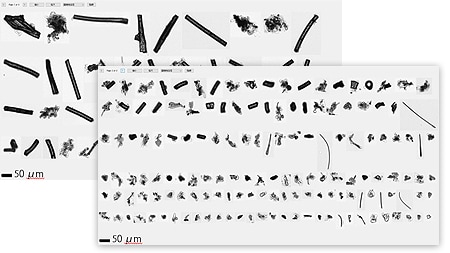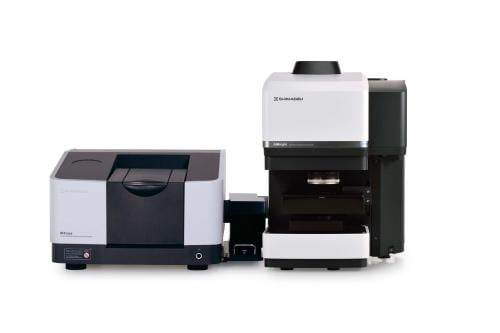Microplastics Dynamic Particle Image Analysis System
A dynamic particle image analysis system is suitable for analysis of the shape and particle count concentration (particles/mL) of microplastics dispersed in solutions. Although analysis of individual microplastic particles is also possible by stereomicroscope, the burden on the operator is large and analysis efficiency is poor. A dynamic particle image analysis system can automatically detect particles with sizes of 5 to 100 μm dispersed in a solution and analyze their shape and particle count concentration in a short time.
Infrared microscope, which excels in analysis of organic compounds, is suitable for qualitative analysis of microplastics with sizes of 100 μm or less that can be captured with filter paper.
Here, we introduce an example of analysis of the shape and particle count concentration of particles contained in environmental water and their qualitative analysis by using a dynamic particle image analysis system and an infrared microscope.

Fig. 1 Particle Images

Fig. 2 Histogram (Frequency Distribution Graph)
From Fig. 1, the shapes of particles with sizes of 100 μm and less have be captured clearly, and various shapes, such as rod- like and fibrous shapes, can be confirmed.

Fig. 3 Visual Observation Image

Fig. 4 Infrared Spectrum of Rod-like Microplastics
As a result of the qualitative analysis of the infrared spectrum (Fig. 4) of the area in the red circle in Fig. 3, this particle was identified as polypropylene (PP).
By using the iSpect DIA-10 dynamic particle image analysis system, the shapes of the large number of particles contained in an environmental water sample could be observed efficiently, and statistical values for the size and shape and information on the particle count concentration could be obtained. The AIM-9000 infrared microscope enabled quick qualitative analysis of the composition of the microplastics captured by visual observation images, and its distribution could be shown clearly by using a chemical image.

Infrared Microscope (AIM)
Using an infrared microscope, microplastics collected on a filter paper can be identified and mapping analysis performed. Minute test samples can be measured with good sensitivity, and component analysis can be rapidly performed using an extensive library of standards.


